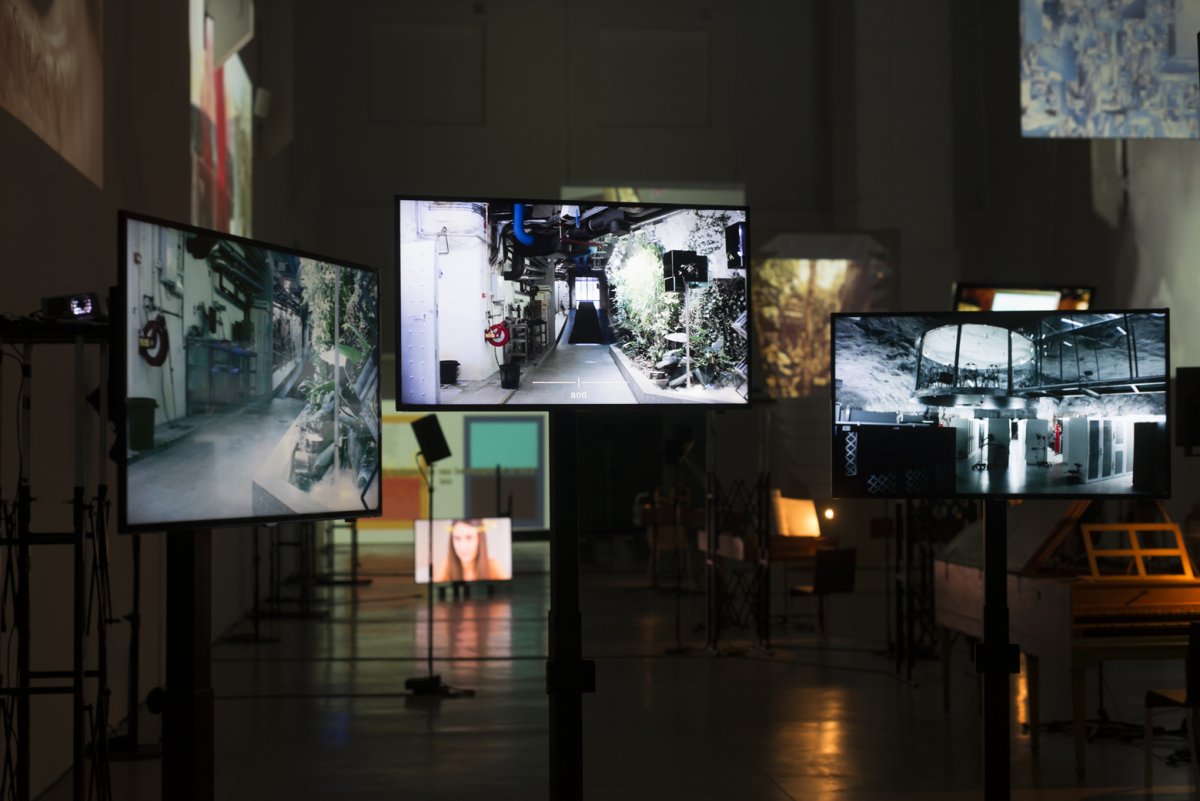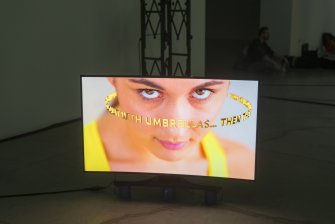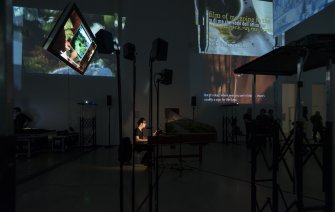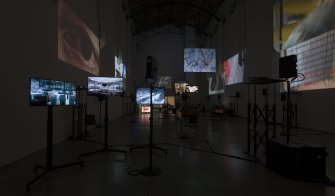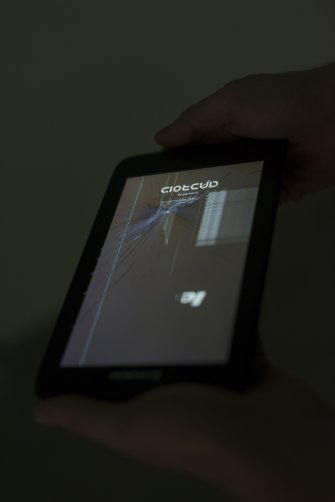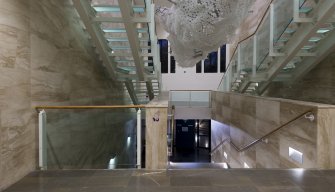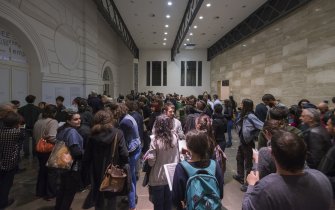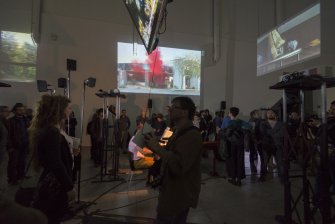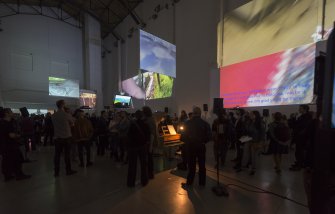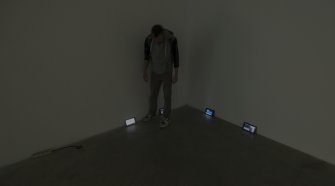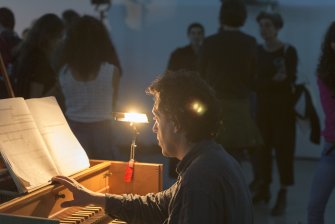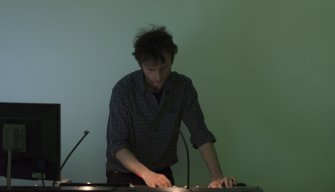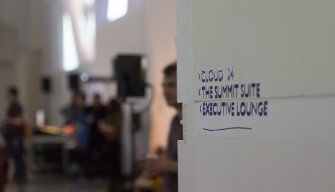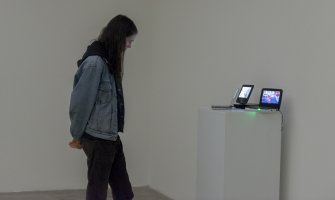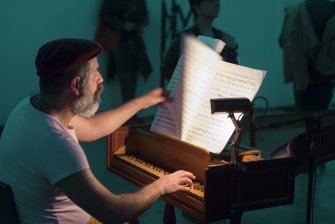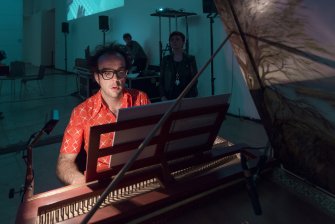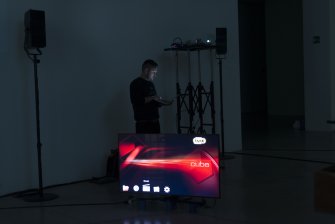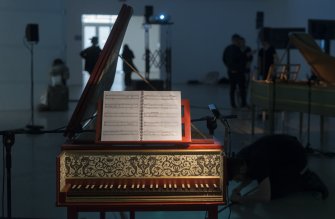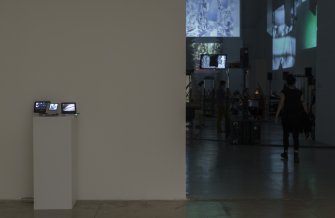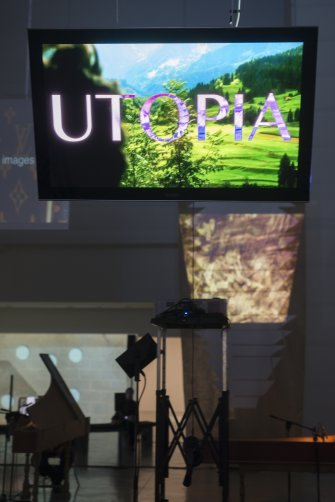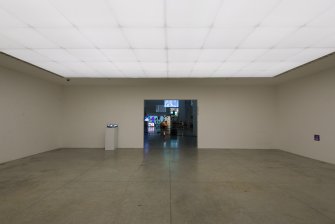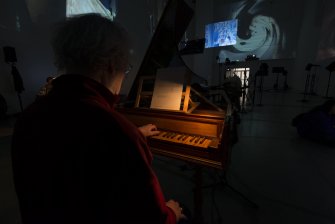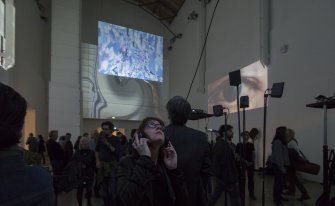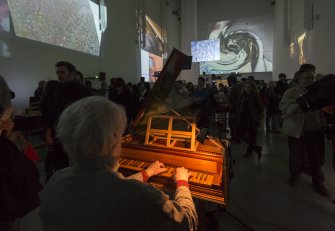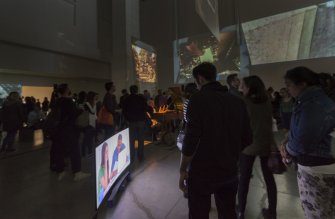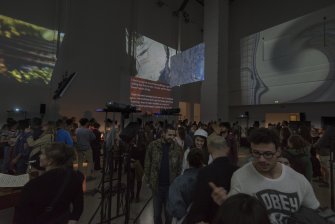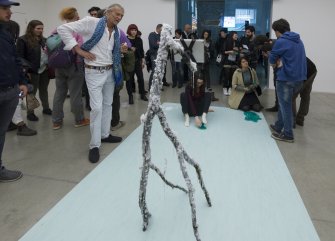HPSCHD 1969>2015 - John Cage, Lejaren Hiller
Riccardo Benassi, Valerio Tricoli , Carola Spadoni, Ogi:no Knauss, Anthony Pateras, Martin Kohout, Salvatore Panu, Marco Dalpane, Luciano Chessa, Philip Corner, Auto Italia, Ilja Karilampi, Roberto Fassone, Andrew Norman Wilson, David Horvitz, Harm van den Dorpel, Anne de Vries, Jaakko Pallasvuo, Jennifer Chan, Yuri Pattison, Holly White, Ben Vickers, Seth Price, Andrea Magnani, Alessandro Di Pietro
HPSCHD, considerata da molti come la più stravagante, colossale e 'rumorosa' composizione musicale del ventesimo secolo, è la leggendaria opera totale che John Cage, in collaborazione con Lejaren Hiller, realizzò nel 1969. Lejaren Hiller, direttore all’epoca del dipartimento di Computer Music dell’Università dell’Illinois, invitò Cage a presentare un progetto che prevedesse l’utilizzo dei calcolatori in relazione a procedimenti stocastici. Siamo agli albori della computer music. Nonostante l'avversione per il clavicembalo ("mi ricorda una macchina da cucire"), Cage elabora l’idea di HPSCHD partendo da una sollecitazione della clavicembalista svizzera Antoinette Vischer. Hiller raccoglie la sfida e si affianca a Cage per la soluzione dei problemi di calcolo e programmazione insiti nella composizione e nell'esecuzione con le tecnologie dell’epoca. Hiller suggerisce, per la felicità di Cage, di utilizzare il metodo compositivo del Gioco dei Dadi, che Mozart usò nel '700 in una sorta di composizione algoritmica ante-litteram. Nasce HPSCHD, un enorme evento multimediale che impiega 7 clavicembali, 208 nastri audio, 59 amplificatori, e un repertorio visivo di 6.400 diapositive (la maggior parte proveniente dalla NASA) e 40 film, proiettati su una superficie schermica circolare lunga 100 metri.
Esprimendo una certa sintonia con il clima tumultuoso di quegli anni, HPSCHD è stato anche un saggio sulla società dell'abbondanza. Cage percepiva il computer come un mezzo capace di prendere un enorme numero di decisioni, ma era la concertazione anarchica dell'insieme l'effetto che voleva creare. Retrospettivamente HPSCHD può essere letto come una risposta preveggente che metteva in risonanza gli studi sulla comunicazione, la società e l'immaginario collettivo di Marshall McLuhan, gli Happenings, l'atterraggio sulla Luna, la storia della musica classica occidentale, le utopie hippy e Buckminster Fuller. E' stato anche un presagio sull'attuale epoca delle Information Technologies e i loro effetti sulla coscienza umana.
Con il progetto HPSCHD 1969>2015 Live Arts Week IV propone a Bologna, nella grande sala delle ciminiere di MAMbo Museo d'Arte Moderna di Bologna, una riedizione singolare di quell’opera multimediale. A MAMbo gli elementi costituivi della composizione musicale sono adeguati alle tecnologie attuali e l'impianto immaginario è stato riattualizzato affidando la sua realizzazione visuale a una nuova generazione di artisti visivi e multimediali (costituita in larga misura da nativi digitali, ovvero la cosiddetta millennial generation) selezionati da Enrico Boccioletti e Daniele Gasparinetti. Per l'esecuzione della parte musicale Xing ha invitato uno dei musicisti che ha partecipato alla prima esecuzione del 1969 assieme a John Cage: Philip Corner, pianista, compositore e artista visivo di area Fluxus, ora ottantenne, in qualità di testimone vivente oltre che esecutore, affiancato da altri musicisti di generazioni successive che si muovono tra musica contemporanea e musica attuale: Luciano Chessa, noto per la riproposizione dell'Intonarumori di Luigi Russolo, l'australiano Anthony Pateras, e gli italiani Marco Dal Pane e Salvatore Panu, con Valerio Tricoli al sound design ed electronics.
Dopo l'esecuzione con i musicisti dal vivo che inaugura Live Arts Week il 21 aprile 2015, tutto l'apparato audiovisuale è visitabile in forma di installazione dal 22 al 26 aprile. La composizione sonora di Cage fornisce in questa modalità uno strano sottofondo come ambiente acustico che accompagna la vera e propria mostra composta dagli interventi audio-visuali selezionati o commissionati ad hoc a diciannove artisti internazionali che rappresentano uno spaccato della produzione visiva contemporanea impegnata nell'analisi della rappresentazione del mondo nell'era digitale e la produzione di nuove estetiche.
*-*-*
artists contributing visuals:
Seth Price (USA) Chords (2006)
Ben Vickers/Holly White (UK) Untitled (2015)
Yuri Pattison (IRL/UK) colocatiom, time displacement (2014)
Carola Spadoni (I/D) Unititled 2010-2015 (2015)
Jennifer Chan (CDN) Screen Saver (2010)
Jaakko Pallasvuo (FIN/D) Utopia (2013)
Ogino Knauss (I/D) K-frame (2015)
Riccardo Benassi (I/D) Phonemenology (The Umbrella Paradigm) (2015)
Andrea Magnani (I) Oṃ the Lam (2015)
Anne de Vries (NL) Forecast (2011)
Harm van Den Dorpel (NL) Strategies (2010)
David Horvitz (USA) The Distance of a Day (2013)
Andrew Norman Wilson (USA) SONE 2014: Chase ATM emitting blue smoke, Bank of America ATM emitting red smoke, TD Bank ATM emitting green smoke (2014)
Martin Kohout (CZ/D) Sjezd (2014)
Roberto Fassone (I) Hey, You Just Step On My Aura! Sorry, My Bad! (Series) (2014>2015)
Alessandro di Pietro (I) Trigger. Concept-Teaser For A Zed And Two Noughts (2015)
Ilja Karilampi (S/D) Untitled (2015)
Auto Italia (UK) Untitled (2015)
visual coordination:
Enrico Boccioletti
harpsichordists:
Philip Corner (USA) Solo VII. Practice or performance of any Mozart composition
Luciano Chessa (I/USA) Solo II. Mozart Dice Game
Marco Dal Pane (I) Solo IV. Dicegame with Mozart composition used as replacements
Anthony Pateras (AUS/D) Solo III. Dicegame with Mozart composition used as replacements
Salvatore Panu (I) Solo I. Computer printout for 12-tone gamut
electronics & sound design:
Valerio Tricoli
in collaboration with:
MAMbo - Museo d’Arte Moderna di Bologna, Fondazione Teatro Comunale di Bologna
technical support:
BH audio, Radio Sata
*-*-*
HPSCHD is the legendary total opera John Cage achieved in collaboration with Lejaren Hiller. It premiered on May 1969 at the Assembly Hall of the University of Illinois, Chicago, and it continues to be appreciated as the most gigantic and loud musical piece of the Twentieth century. Lejaren Hiller, the director of the Computer Music dept. of the University of Illinois, invited John Cage to present a project based on the application of calculating devices and stochastic processes. Cage proposed the basic concept of HPSCHD, inspired by an idea from Swiss harpsichordist Antoinette Vischer. Accepting the challenge, Hiller worked alongside Cage for the score and the performance, as well as solving computational and programming problems related to technology in those days. HPSCHD was born: it was a huge multi-media event, featuring 7 harpsichords, 208 recorded tapes, 59 amplifiers and 52 tape-players, all of which was organised into 13 sections. Regarding visuals, the work took advantage of an archive of 6.400 slides (5.000 courtesy of NASA), 64 slide projectors, 40 films projected by 8 projectors on a one hundred meter circular display specifically conceived.
The very nature of HPSCHD is inextricable from the tumult of the year it premiered, as an essay on the subject of abundance. Cage saw the computer as a means of making an enormous number of decisions, hence producing an abundance of music for delivery in a circus atmosphere: it was the quantity and the anarchic arrangement of the whole that create the effect. 1969 is the year when Buckminster Fuller’s Utopia or Oblivion was published, nearly twenty years after Norbert Wiener’s The Human Use of Human Beings (1950) and four years after Understanding Media: The Extentions of Man by Marshall McLuhan (1964). HPSCHD could somehow depict Cage’s reply to this sequence of forward-thinking works, encouraging mankind to take part in a big thought experiment and finally come to terms with the universal–rather than global–perception, which postwar society was inevitably to acquire. His reply was properly 'Cagean': virtually endlessly ambivalent and random by method, per se. It was the first enactment or, so to speak, a first 'listening' of big data.
HPSCHD 1969>2015, produced by Xing for Live Arts Week 2015 at MAMbo Museo d'Arte Moderna di Bologna, reinterprets that trailblazing piece: both an homage, and an occasion to update and debate, thanks to the cooperation of forces from both the avant-garde generation peer to the original event, and either the so-called digital natives or Millennial generation. In the Bologna project the core elements of the musical score has been observed according to a few necessary technical updates. A visual rework is definitely worth the effort of a much more flexible interpretation, including a new series of commissions to young post-digital artists, scanning through big data networks in search of inspiration, finding what, back in 1969, was beyond imagination. In the present moment of transition and ambiguity, HPSCHD 1969>2015 is conceived with the purpose to examine this complicated phase of contemporary visual culture.
For the music part of the performance, Xing has invited one of the musicians who took part in the first performance in 1969 along with John Cage: Philip Corner, pianist, composer and visual artist of the Fluxus movement, now in his eighties, a living witness as well as performer. He will perform alongside some other musicians from later generations who work in contemporary and current music: Luciano Chessa, known for his reinterpretation of the Intonarumori by Luigi Russolo; the Australian musician Anthony Pateras; and Italian musicians Marco Dal Pane and Salvatore Panu, with sound design and electronics by Valerio Tricoli.
After the live performance which opens Live Arts Week featuring also these musicians, all the visual contributions are on display as an installation for an entire week. Cage's sound composition thus provides an unusual backdrop, an acoustic environment to accompany this exhibition of the audio-visual works that have been selected or specially assigned by Enrico Boccioletti and Daniele Gasparinetti to 19 international artists who represent a specific area of contemporary visual arts that seeks to analyse the representation of the world in the digital sphere as well as the production of new aesthetics.

